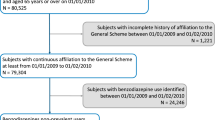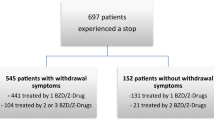Abstract
Objective
The aim of the study was to identify initial usage predictors for prolonged benzodiazepine use.
Methods
An 8-year pharmacy data-based study (1983–1992) was carried out on a retrospective cohort of 425 initial benzodiazepine users. The setting was the only pharmacy in a community of 13,500 people.
Results
Among the 425 initial users, 36% had a single initial exposure year, 50% had two to seven exposure years, and 14% had benzodiazepine use during all 8 years of follow-up. Prolonged use over more years was associated with an initial high number of prescriptions, elderly patients and initial use of hypnotics. Two patterns of irregular prolonged use were investigated: increase in use was associated with a shorter length of the first usage period and switching to another benodiazepine during the first 90 days; relapses of use were associated with a shorter length of first usage period and initial use of an anxiolytic. Gender and initial dosage were not associated with prolonged use at all.
Conclusion
During the first 90 days after initiation of benzodiazepine use, a number of determinants of prolonged benzodiazepine use were visible. The prescribers of these drugs and the pharmacists should advise rational use not only at the start but also at the moment of the first repeat prescription in order to prevent needless prolonged use and dependence.
Similar content being viewed by others
References
Dunbar GC, Perera MH, Jenner FA (1994) Patterns of benzodiazepine use in Great Britain as measured by a general population survey. Br J Psychiatry 155:836–841
Olfson M, Pincus HA (1994) Use of benzodiazepines in the community. Arch Int Med 154:1235–1240
Koenig W, Ruther E, Remmers A et al (1987) Psychotropic drug utilisation patterns in a metropolitan population. Eur J Clin Pharmacol 32:43–51
Van Hulten R, Leufkens HG, Bakker A (1998) Usage patterns of benzodiazepines in a Dutch community. Pharm World Sci 20:78–82
Lader M (1983) Dependence on benzodiazepines. J Clin Psychiatry 44:121–127
Busto U, Sellers EM, Nuranjo CA et al (1986) Withdrawal reaction after long-term therapeutic use of benzodiazepines. N Engl J Med 315:854–859
Central Medical Pharmaceutical Committee of the Council of the Dutch National Health Service (1996) Pharmaceutical compass 1996 (in Dutch). Council of the Dutch National Health Service, Amstelveen
Van der Waals FW, Mohrs J, Foets M (1993) Sex differences among recipients of benzodiazepines in Dutch general practice. BMJ 307:363–366
Isacson D, Carsjo K, Bergman U, Blackburn JL (1992) Long-term use of benzodiazepines in a Swedish community: an eight-year follow-up. J Clin Epidemiol 45:429–436
Simon GE, VonKorff M, Barlow W, Pabiniak C, Wagner E (1996) Predictors of chronic benzodiazepine use in a health organization sample. J Clin Epidemiol 49:1067–1073
Mant A, Mattick RP, De Brugh S, Donnelly N, Hall W (1995) Benzodiazepine prescribing in general practice: dispelling some myths. Fam Pract 12:37–43
Isacson D (1997) Long-term benzodiazepine use: factors of importance and the development of individual use patterns over time—a 13-year follow-up in a Swedish community. Soc Sci Med 44:1871–1880
World Health Organization (1993) Anatomical Therapeutic Chemical (ATC) classification index. World Health Organization Collaborating Centre for Drug Statistics Methodology, Oslo
Hekster YA, Vree TB, Goris RJ, Boerema JB (1982) The defined daily dose per 100 bed-days as a unit of comparison and a parameter for studying antimicrobial drug use in a university hospital. J Clin Hosp Pharm 7:251–260
Mendels J (1991) Criteria for selection of appropriate benzodiazepine hypnotics therapy. J Clin Psychiatry 1991:42–46
Volkerts ER, van Laar MW, Willigenburg APP, Plomp TA, Maes RAA (1992) A comparative study of on-road simulated driving performance after nocturnal treatment with lormetazepam 1 mg and oxazepam 50 mg. Hum Psychopharmacol 7:297–309
Kleinbaum DG, Kupper LL, Muller KE (1988) Applied regression analysis and other multivariate methods. PWS-Kent Publishing Company, Boston
Mant A, Duncan-Jones P, Saltman D, Bridges-Webb C, Kehoe L, Lansbury G, Chancellor A (1988) Development of long-term use of psychotropic drugs by general practice patients. BMJ 296:251–254
Swartz M, Landerman R, George LK, Melville ML, Blazer D, Smith K (1991) Benzodiazepine anti-anxiety agents: prevalence and correlates of use in a southern community. Am J Publ Health 81:592–596
Busto U, Bendayan R, Sellers E (1989) Clinical pharmacokinetics of non-opiate abused drugs. Clin Pharmacokinet 16:1–26
Cappell H, Busto U, Kay G, Naranjo C, Sellers EMCS (1987) Drug deprivation and reinforcement by diazepam in a dependent population. Psychopharmacology 91:154–160
Smith DE, Wesson DR (1983) Benzodiazepine dependence syndromes. J Psychoactive Drugs 15:85–95
Martinez-Cano H, Vela-Bueno A, De Iceta M, Pomalima R, Martinez-Graz I, Paz Sobrino M (1996) Benzodiazepine types in high versus therapeutic dose dependence. Addiction 91:1179–1186
Davidson JRT (1990) Continuation treatment of panic disorder with high potency benzodiazepines. J Clin Psychiatry 51:31–37
Rickels K, Schweizer E, Case WG, Greenblatt DJ (1988) Long-term therapeutic use of benzodiazepines, effects of abrupt discontinuation. Arch Gen Psychiatry 45:444–450
Hallfors DD, Saxe L (1993) The dependence potential of short half-life benzodiazepines: a meta-analysis. Am J Publ Health 83:1300–1304
Schweizer E, Rickels K, Case WG, Greenblatt DJ (1990) Long-term therapeutic use of benzodiazepines, effects of gradual taper. Arch Gen Psychiatry 47:908–915
Herings RMC, Stricker BHC, De Boer A, Bakker A, Sturmans F (1995) Benzodiazepines and the risk of falling leading to femur fractures. Arch Int Med 155:1801–1807
Rodrigo EK, King MB, Williams P (1988) Health of long-term benzodiazepine users. BMJ 296:603–606
Van Hulten R, Teeuw KB, Bakker AB, Bakker A, Leufkens HG (2000) Characteristics of current benzodiazepine users as indicators of differences in physical and mental health. Pharm World Sci 22:96–101
Fourrier A, Letenneur L, Dartigues JF, Moore N, Begaud B (2001) Benzodiazepine use in an elderly community-dwelling population. Characteristics of users and factors associated with subsequent use. Eur J Clin Pharmacol 57:419–425
Van Hulten R, Heerdink ER, Bakker A, Leufkens HG (1999) Benzodiazepine pathways in the chronically ill. Pharmacoepidemiol Drug Saf 8:325–330
Uhlenhuth EH, Balter MB, Mellinger GD (1993) Clinical variables in pharmacoepidemiology. J Psychiatr Res 278[Suppl 1]:89–95
Author information
Authors and Affiliations
Corresponding author
Classification of benzodiazepines in study population
Classification of benzodiazepines in study population
-
Short t1/2: bromazepam, flunitrazepam, lorazepam, oxazepam, temazepam
-
Long t1/2: chlordiazepoxide, clobazam, clorazepic acid, diazepam, flurazepam, nitrazepam, nordazepam, prazepam
-
Fast tmax: bromazepam, chlordiazepoxide, clorazepic acid, diazepam, flunitrazepam, flurazepam, temazepam
-
Slow tmax: clobazam, lorazepam, nitrazepam, nordazepam, prazepam, oxazepam
-
5-aryl halog: flunitrazepam, flurazepam, lorazepam
-
No 5-aryl halog: bromazepam, chlordiazepoxide, clobazam, clorazepic acid, diazepam, nitrazepam, nordazepam, oxazepam, prazepam, temazepam
Rights and permissions
About this article
Cite this article
van Hulten, R., Teeuw, K.B., Bakker, A. et al. Initial 3-month usage characteristics predict long-term use of benzodiazepines: an 8-year follow-up. Eur J Clin Pharmacol 58, 689–694 (2003). https://doi.org/10.1007/s00228-002-0548-0
Received:
Accepted:
Published:
Issue Date:
DOI: https://doi.org/10.1007/s00228-002-0548-0




